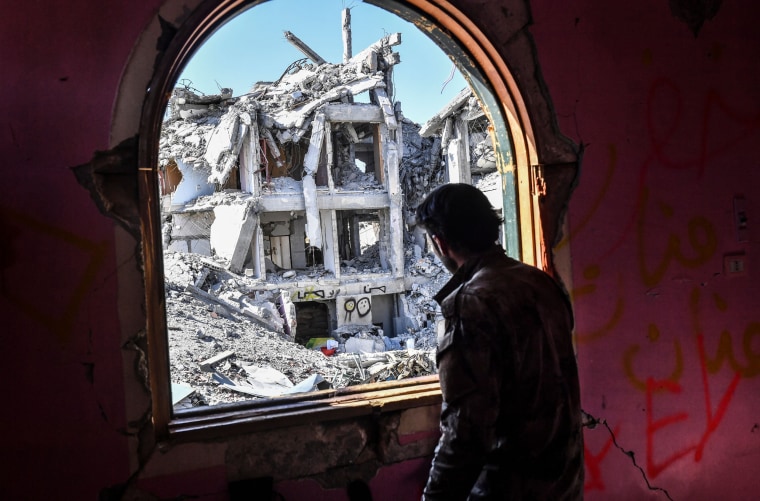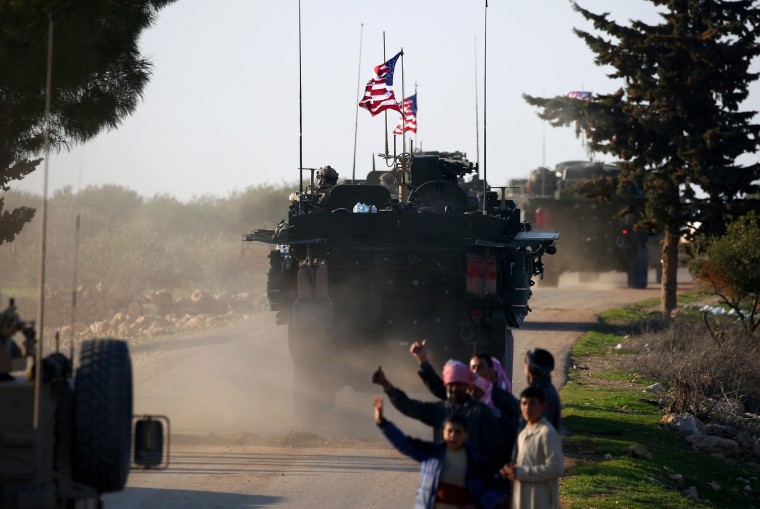By Courtney Kube, Josh Lederman and Carol E. Lee
 WASHINGTON — A draft Pentagon report warns that without continued pressure, ISIS could regain territory in six to 12 months, according to two U.S. officials familiar with the draft.
WASHINGTON — A draft Pentagon report warns that without continued pressure, ISIS could regain territory in six to 12 months, according to two U.S. officials familiar with the draft.The finding is in a draft of the Department of Defense Inspector General Quarterly Report about Operation Inherent Resolve that is expected to be released early next week. The report draws on information from the U.S. military, U.S. government agencies, and open source reports.
The draft says ISIS is intent on reconstituting a physical caliphateand that with ungoverned spaces in Syria and no military pressure, the terror group could retake land in a matter of months, according to the officials familiar with the report.
The report covers the three months from Oct. 1 to Dec. 31, 2018. President Donald Trump announced on Dec. 19 that the U.S. military would be leaving Syria.
"We have defeated ISIS in Syria," said Trump via Twitter, "my only reason for being there during the Trump Presidency."
This week the Acting Secretary of Defense Patrick Shanahan agreed. "If we wind the clock back two years, I'd say 99.5 percent plus of the ISIS-controlled territory has been returned to the Syrians," he said during a briefing Tuesday. "Within a couple weeks, it'll be 100 percent."
The Defense Department Office of Inspector General declined to comment on the draft report prior to its release. The National Security Council had no immediate comment.
House Foreign Affairs Committee Chairman Eliot Engel, D-N.Y., responded to the NBC News report about the draft by calling it a clear indication from the Pentagon that “ISIS has not been defeated.”
“If the President didn’t ignore his senior intelligence officials, perhaps he would arrive at the same conclusion,” Engel said.
The number of U.S. troops in Syria has spiked to around 3,000 in recent days as more troops have moved in to help with the withdrawal, according to defense officials. Logistical support and security forces are in the country to help move equipment and eventually troops out.
The U.S. military remains under orders for a complete withdrawal of all U.S. troops in 120 days, ending the U.S. presence there in mid-spring.
Top Trump officials have acknowledged publicly the risk that the extremists could regroup.
"We need to continue to do all that we can to make sure that there's not a resurgence of ISIS or that all the other variants of that terror regime continue to be under pressure," Secretary of State Mike Pompeo told Fox News this week.
In public testimony Tuesday, during the Senate Intelligence Committee's annual Worldwide Threat Assessment hearing, Director of National Intelligence Dan Coats and other intelligence officials seemed to be at odds with Trump's characterization of the situation in Syria. Coats said that while ISIS was "nearing" military defeat in Iraq, it had returned to its "guerrilla warfare roots," continued to plot attacks and "still commands thousands of fighters in Iraq and Syria."
But on Thursday, Trump tweeted that he had just concluded a meeting with his "Intel team" and that they "told me what they said on Tuesday at the Senate Hearing was mischaracterized by the media — and we are very much in agreement on Iran, ISIS, North Korea, etc."
Trump is expected to provide an update on progress against ISIS when he delivers his State of the Union address Tuesday.
Two U.S. officials said the territory ISIS holds in the Euphrates River Valley is now less than 10 kilometers wide, but the push to clear that last area is slow-going.
The Trump administration has argued that the mission of fighting ISIS and preventing its return will continue, just with a "tactical" shift that no longer involves U.S. troops on the ground. Fred Fleitz, the former chief of staff to National Security Adviser John Bolton, said the U.S. would continue carrying out airstrikes and intelligence operations from Iraq, where Trump has said U.S. troops will remain.A U.S. armored vehicles convoy drives near the village of Yalanli, Syria, on March 5, 2017.Delil Souleiman / AFP - Getty Images file
 "[Syria has] been a mess, it's going to remain a mess when we leave," Fleitz told NBC News. "What the administration is trying to do is find the least bad option to get our troops out."
"[Syria has] been a mess, it's going to remain a mess when we leave," Fleitz told NBC News. "What the administration is trying to do is find the least bad option to get our troops out."As the U.S.-backed Syrian Democratic Forces move towards the last ISIS pocket, they are faced with hundreds of civilians streaming out of the ISIS-controlled area. That has prompted serious concerns that ISIS fighters, anticipating imminent defeat, will masquerade as civilians and try to flee along with them, essentially using the civilians who have been living under their control as human shields, several U.S. officials said. A similar concern slowed the SDF's assault on Raqqa, the former "capital" of the ISIS caliphate, in late 2017.
To prevent ISIS fighters from escaping undetected, the SDF has been screening and gathering biometrics on the civilians to ensure they aren't fleeing fighters. All males of fighting age are considered suspect until proven otherwise, officials said, with biometric information being run through databases to identify any known fighters.
 Those who raise red flags as potential foreign fighters in Syria are run through Interpol's global databases. Officials said that those who are cleared are allowed to continue on to camps for internally displaced people in Syria, where they remain under close monitoring.
Those who raise red flags as potential foreign fighters in Syria are run through Interpol's global databases. Officials said that those who are cleared are allowed to continue on to camps for internally displaced people in Syria, where they remain under close monitoring.Although current plans call for a withdrawal of all U.S. troops by mid-spring, there has been continuing debate about the possibility of the U.S. keeping a small contingent of troops at Al Tanf, in southern Syria, a location seen as critical to limiting the spread of Iranian influence in Syria. Bolton, the national security adviser, has pushed for keeping some troops there, in a nod to Israeli concerns about the proliferation of Iran-backed forces operating close to its border with Syria.
U.S. officials said that Al Tanf will be the last place in Syria from which U.S. troops will withdraw, potentially creating an opening for Trump to change his mind and agree to keeping some troops in Syria.
Another question mark hangs over the future of northern Syria as the U.S. withdraws. Since Trump's announcement, the Trump administration has been haggling with Turkey over its concerns about Kurdish forces who make up the bulk of the SDF remaining near the Syria-Turkey border.
But discussions over a possible "safe zone" along the border to separate Turkey from Kurdish forces that Ankara considers terrorists have yet to yield agreement over key issues such as who would patrol the zone, U.S. officials said. In the absence of a deal with the U.S., Turkey's government has been discussing options with Russia and Iran – another worrying development for the U.S.
 Concerns about ISIS attempting to rebuild a caliphate in both Syria and Iraq after the U.S. departs were echoed in the annual Worldwide Threat Assessment released by the U.S. intelligence community this week in conjunction with Tuesday's Senate testimony.
Concerns about ISIS attempting to rebuild a caliphate in both Syria and Iraq after the U.S. departs were echoed in the annual Worldwide Threat Assessment released by the U.S. intelligence community this week in conjunction with Tuesday's Senate testimony."We assess that ISIS will seek to exploit Sunni grievances, societal instability, and stretched security forces to regain territory in Iraq and Syria in the long term," the report says.
"ISIS still commands thousands of fighters in Iraq and Syria, and it maintains eight branches, more than a dozen networks, and thousands of dispersed supporters around the world, despite significant leadership and territorial losses. The group will exploit any reduction in CT pressure to strengthen its clandestine presence and accelerate rebuilding key capabilities, such as media production and external operations. ISIS very likely will continue to pursue external attacks from Iraq and Syria against regional and Western adversaries, including the United States."
The report also finds the Syrian regime is unlikely to go after ISIS unless the terror group is threatening government infrastructure.
